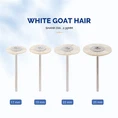Hey there! As a dental occlusal pad supplier, I've seen firsthand how important it is to choose the right dental occlusal pad. Whether you're a dentist, a dental hygienist, or just someone looking to take better care of your teeth, picking the right occlusal pad can make a world of difference. In this blog, I'll share some tips on how to make that choice.
Understanding Dental Occlusal Pads
First things first, let's talk about what dental occlusal pads are. These are small, usually soft, pads that are placed between the teeth. They're used for a variety of reasons, like protecting the teeth during certain dental procedures, helping with bite alignment, or reducing the impact of teeth grinding.
If you're curious about the dental occlusal pads we offer, you can check them out Dental Occlusal Pad.
Factors to Consider When Choosing
Material
The material of the occlusal pad is crucial. There are different types of materials available, each with its own pros and cons.
- Silicone: Silicone occlusal pads are very popular. They're soft, flexible, and comfortable to wear. They also have good durability, which means they can last for a while. Plus, silicone is hypoallergenic, so it's a great option for people with sensitive mouths.
- Latex: Latex pads used to be more common, but due to the risk of latex allergies, their use has decreased. However, if you're not allergic, latex pads can be quite effective. They're also relatively inexpensive.
- Plastic: Plastic occlusal pads are often rigid and can provide more support. They're a good choice for procedures where you need a more stable bite. You can also explore Plastic Dental Wedges which are related to dental support products.
Size and Shape
The size and shape of the occlusal pad need to fit your mouth properly. If it's too big, it can be uncomfortable and may not stay in place. If it's too small, it won't provide the necessary support.
- Adult vs. Child: Obviously, adults and children have different mouth sizes, so there are pads designed specifically for each. Make sure to choose the right one based on the age of the user.
- Bite Pattern: Some people have different bite patterns, like an overbite or an underbite. There are occlusal pads that are designed to accommodate these specific bite issues.
Thickness
The thickness of the pad can affect how it feels in your mouth and how well it works.
- Thin Pads: Thin pads are less noticeable and can be more comfortable for everyday wear. They're a good option if you're using the pad for a long time, like when you're sleeping to prevent teeth grinding.
- Thick Pads: Thick pads provide more cushioning and support. They're often used during dental procedures to protect the teeth and gums.
Purpose
What you're using the occlusal pad for also plays a big role in your choice.
- Dental Procedures: If you're a dentist using the pad during a procedure, you'll want one that provides good stability and protection. You may need a pad that can withstand the pressure of dental tools.
- Teeth Grinding: For people who grind their teeth at night, you'll need a pad that can absorb the impact and protect the teeth from damage.
- Bite Alignment: If the goal is to correct a bite issue, you'll need a pad that's designed to gradually adjust the bite over time.
Our Product Range
As a supplier, we offer a wide range of dental occlusal pads to meet all these different needs. We also have HP Flat Prophy Brush which can be used in conjunction with the occlusal pads for better dental care.


Our silicone pads are made from high - quality materials that are both comfortable and durable. We have different sizes and thicknesses available to suit various mouth sizes and purposes. Our plastic pads are designed to be rigid and provide excellent support during dental procedures.
Tips for Trying Out a New Pad
Once you've chosen an occlusal pad, here are some tips to make sure it works well for you.
- Break - In Period: Give your mouth some time to get used to the pad. It may feel a bit strange at first, but after a few days, you should start to feel more comfortable.
- Cleaning: Keep the pad clean to prevent bacteria buildup. You can usually clean it with mild soap and water.
- Check for Fit Regularly: Over time, your mouth may change slightly, so it's a good idea to check the fit of the pad every once in a while. If it starts to feel uncomfortable or doesn't seem to be working as well, it may be time to get a new one.
Conclusion
Choosing the right dental occlusal pad is not as simple as it may seem. There are many factors to consider, from the material and size to the purpose. But by taking the time to think about these things, you can find a pad that works well for you or your patients.
If you're interested in our dental occlusal pads or have any questions about choosing the right one, don't hesitate to reach out. We're here to help you make the best choice for your dental needs. Whether you're a dental professional looking to stock up on supplies or an individual looking for a solution to teeth grinding, we've got you covered. Let's start a conversation about your dental occlusal pad needs and find the perfect fit for you.
References
- Dental textbooks on oral anatomy and dental materials.
- Industry research papers on the effectiveness of different dental occlusal pad materials.



